

zx46
Project 1 (individual), by zhiguang xue. An analysis of General Motors’ information systems and their usage for the firm’s wider strategic objectives. Cost-efficiencies aimed at overcoming regional differences relating todevelopment and design.
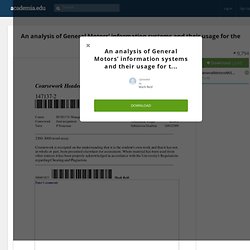
To that end, GM has adopted a globalpurchasing strategy (Anonymous, 2007). Strengthen investment in fuel-efficient technologies, as well as ensuringthat all regulatory requirements appertaining to environmental issues aresatisfactorily addressed (Stein: 1). Both activities involve huge costs,therefore it is vital that systems are in place to accommodate theseoutlays in the most efficient manner possible (Ibid) To have the capacity to build identical vehicles at any manufacturingplant, regardless of its geographical location. This requires theestablishment of a common framework which provides a unified design,purchasing, and sourcing capability on a global scale. Activities. S concept of lean manufacturing has made it the industryleader.
Plant as an exercise incollaborative learning. provided GM with a detailed insight intohow Toyota excels at product efficiency. Technical Liaison Office Global. Cisco-AutoCaseStudy-GM.pdf. Essentials of Management Information Systems, 2/E - ADDITIONAL CASE STUDY 1. Chrysler and GM: Can Information Technology Turn Around the U.S.
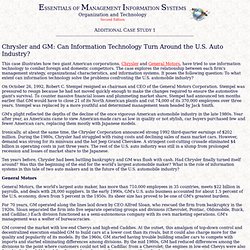
Auto Industry? This case illustrates how two giant American corporations, Chrysler and General Motors, have tried to use information technology to combat foreign and domestic competitors. The case explores the relationship between each firm's management strategy, organizational characteristics, and information systems. It poses the following question: To what extent can information technology solve the problems confronting the U.S. automobile industry?
On October 26, 1992, Robert C. GM's plight reflected the depths of the decline of the once vigorous American automobile industry in the late 1980s. Ironically, at about the same time, the Chrysler Corporation announced strong 1992 third-quarter earnings of $202 million. An analysis of General Motors’ information systems and their usage for the firm’s wider strategic objectives. Information Systems. 4.
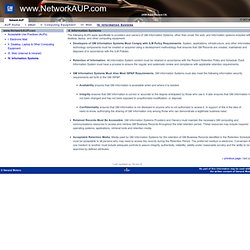
Information Systems The following AUPs apply specifically to providers and owners of GM Information Systems, other than email, the web, and information systems included with desktop, laptop, and other computing equipment: Developers of GM Information Systems Must Comply with ILM Policy Requirements. System, applications, infrastructure, and other information technology components must be created or acquired using a development methodology that ensures that GM Records are created, maintained and disposed of in accordance with the ILM Policies.
The corporate culture: Behind the scenes at General Motors. Cole said he believes GM's culture is ripe to be molded by a head coach after years of being ruled by kings.
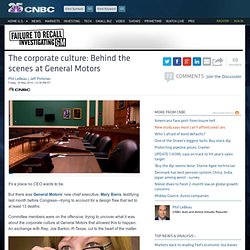
"The management at GM has the desire to be coached, and Mary is ready to lead the team," Cole said. "Mary believes everyone inside GM is important, and that will filter through the company. There are talented people in GM ready to follow her lead. " Read MoreFierce headwinds: GM's past dragging on its future Keller, who has often been highly critical of GM, said she thinks Barra can transform GM's culture. "If she can use this as a seminal moment to convince everybody that this really is a company where everybody has to take individual responsibility, and most importantly, will be held accountable," Keller said. The fact remains, however, that GM is packed with thousands of workers who were hired and worked in a culture where making numbers every quarter was the main focus. Getting those workers, the core of GM, to focus first on the customer won't be easy, analysts say. Organizational structure.
An organizational structure defines how activities such as task allocation, coordination and supervision are directed towards the achievement of organizational aims.[1] It can also be considered as the viewing glass or perspective through which individuals see their organization and its environment.[2] Organizations are a variant of clustered entities.
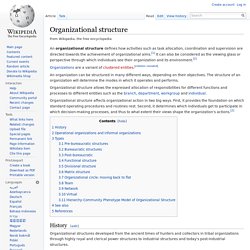
[citation needed] An organization can be structured in many different ways, depending on their objectives. The structure of an organization will determine the modes in which it operates and performs. Network Structure- Common Structures. Advantages & Disadvantages of Matrix Organizational Structures in Business Organizations. Matrix management. A matrix organization Strictly speaking matrix management is the practice of managing individuals with more than one reporting line (in a matrix organization structure), but it is also commonly used to describe managing cross functional, cross business group and other forms of working that cross the traditional vertical business units – often silos - of function and geography.

What is matrix management? [edit] It is a type of organizational management in which people with similar skills are pooled for work assignments, resulting in more than one manager (sometimes referred to as solid line and dotted line reports, in reference to traditional business organization charts). For example, all engineers may be in one engineering department and report to an engineering manager, but these same engineers may be assigned to different projects and report to a different engineering manager or a project manager while working on that project. The Matrix for project management[edit] Flat Vs. Hierarchical Organizational Structure. What is flat organization? definition and meaning. Flat organization. A flat organization (also known as horizontal organization or delayering) is an organization that has an organizational structure with few or no levels of middle management between staff and executives.

The idea is that well-trained workers will be more productive when they are more directly involved in the decision making process, rather than closely supervised by many layers of management. The flat organization model promotes employee involvement through a decentralized decision-making process. By elevating the level of responsibility of baseline employees and eliminating layers of middle management, comments and feedback reach all personnel involved in decisions more quickly.
Expected response to customer feedback becomes more rapid. Self-managing teams[edit] The "strong form" of a flat organization is an organization with no middle managers at all. However, some organizations do not take on middle managers even as they become larger, and remain extremely flat. File:Hierarchy Community Phenotype Model of Organizational Structure.pdf.
NJIT Login Service.